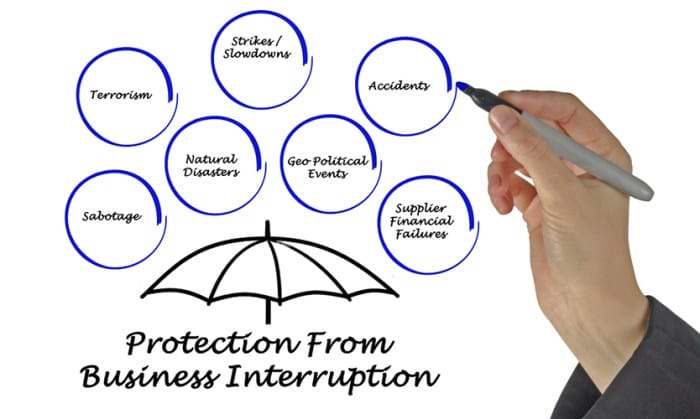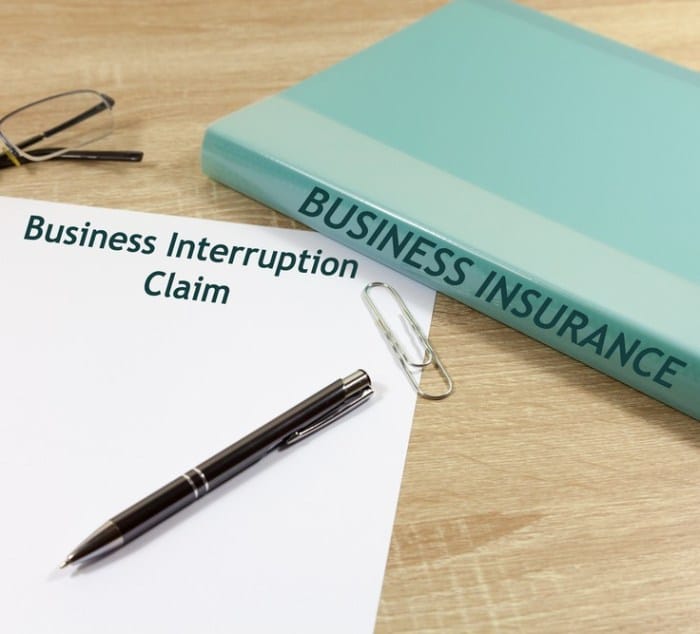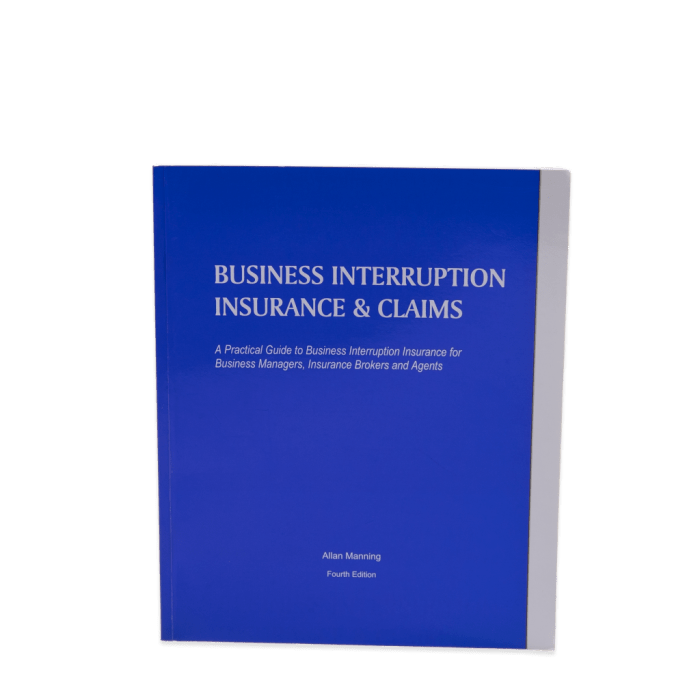In the unfortunate event of a business interruption, having the right insurance coverage can provide a lifeline for your company. However, navigating the claims process can be complex and challenging. Here’s a comprehensive guide to help you maximize your business interruption insurance claim and ensure a smooth recovery.
This guide will take you through the intricacies of business interruption insurance claims, from documenting the interruption and identifying covered losses to calculating the claim amount and preparing a comprehensive claim. We’ll also delve into strategies for negotiating a fair settlement, avoiding common pitfalls, and maintaining business continuity during the interruption period.
Documenting the Interruption

Maintaining thorough and accurate documentation is crucial in supporting business interruption insurance claims. Proper records help insurance companies assess the extent of losses and expedite the claims process.
During the interruption period, meticulously maintain records of all expenses incurred and income lost due to the disruption. These records serve as essential evidence in substantiating your claim.
Gathering Relevant Documentation
-
Compile Financial Records:
Gather financial statements, invoices, receipts, and bank statements that reflect the financial impact of the interruption. -
Document Business Activities:
Maintain detailed records of business operations, including sales figures, customer interactions, and production schedules. -
Preserve Communication Records:
Keep copies of emails, letters, and phone records related to the interruption and its impact on business operations. -
Capture Images and Videos:
Take photos or videos of the affected business premises, damaged property, and any other relevant visual evidence.
Maintaining Accurate Records
-
Timely Documentation:
Record expenses and losses promptly. Delay in documentation can lead to inaccurate or incomplete records. -
Organized Records:
Maintain a well-organized system for storing and retrieving records. This ensures easy access when needed. -
Consistency in Record-Keeping:
Use consistent methods and formats for recording financial data and business activities throughout the interruption period.
Identifying Covered Losses

Business interruption insurance policies provide coverage for various losses resulting from a covered peril, such as fire, natural disasters, or civil unrest. Understanding the types of losses covered under your policy is crucial to ensure you receive appropriate compensation for your claim.
Commonly covered losses under business interruption insurance include:
Lost Profits
Lost profits are the net income you would have earned during the interruption period if the covered peril had not occurred. This includes:
- Gross sales minus the cost of goods sold, operating expenses, and other expenses that would have been incurred during the interruption period.
- Lost profits from contracts or agreements that could not be fulfilled due to the interruption.
- Lost profits from the sale of damaged or destroyed inventory.
Extra Expenses
Extra expenses are the additional costs incurred to continue operations during the interruption period, such as:
- Temporary relocation expenses, such as rent, utilities, and equipment.
- Increased transportation costs due to rerouting or alternative shipping methods.
- Overtime pay for employees working extra hours to maintain operations.
- Additional advertising and marketing expenses to attract customers back after the interruption.
Property Damage
Property damage refers to the physical damage to your business property, such as buildings, equipment, and inventory, caused by a covered peril. This includes:
- Repair or replacement of damaged property.
- Loss of value of damaged property.
- Loss of income due to the inability to use damaged property.
It is important to note that the specific coverage and limitations for each type of loss may vary depending on the terms and conditions of your business interruption insurance policy. Carefully review your policy to understand the covered losses, exclusions, and any applicable limits or deductibles.
Calculating the Claim Amount
Establishing the exact monetary value of a business interruption insurance claim is crucial. There are various approaches to determine the claim amount, each with its own merits and suitability depending on the specific circumstances and available documentation.
The primary objective is to accurately quantify the financial losses incurred as a direct result of the interruption. This includes not only the immediate revenue loss but also the ongoing expenses that continue despite the disruption.
Financial Data and Projections
Accurate and comprehensive financial data is the cornerstone of calculating a business interruption insurance claim. This includes historical financial statements, such as income statements, balance sheets, and cash flow statements. These documents provide a clear picture of the business’s financial performance before the interruption, establishing a baseline for comparison.
In addition to historical data, projections of future financial performance are also essential. These projections should be based on sound assumptions and credible evidence, such as industry trends, market analysis, and the company’s own historical growth patterns. These projections help quantify the potential income that would have been generated had the interruption not occurred.
Methods for Calculating the Claim Amount
There are several recognized methods for calculating the business interruption insurance claim amount. The choice of method depends on factors such as the type of business, the nature of the interruption, and the availability of financial data.
- Gross Earnings Method: This method calculates the claim amount by subtracting the actual gross earnings during the interruption period from the projected gross earnings that would have been achieved in the absence of the interruption.
- Net Income Method: This method focuses on the net income or profit lost due to the interruption. It involves subtracting the actual net income during the interruption period from the projected net income that would have been achieved without the interruption.
- Loss of Profits Method: This method calculates the claim amount based on the gross profit that would have been earned during the interruption period, less the expenses that would have been incurred during that time.
- Extra Expense Method: This method is used when the interruption results in additional expenses that would not have been incurred in the normal course of business. The claim amount is calculated by totaling these extra expenses.
Each of these methods has its own advantages and limitations. The choice of method should be made in consultation with an insurance professional or a qualified accountant who is experienced in handling business interruption insurance claims.
Preparing the Claim
Submitting a business interruption insurance claim can be a complex process, but with careful preparation and organization, businesses can ensure their claim is comprehensive, well-documented, and effectively presented to the insurance company.
Step 1: Gather Necessary Information
Begin by gathering all relevant information and documentation pertaining to the business interruption. This includes:
- Insurance policy details, including the policy number, coverage limits, and terms and conditions.
- Business financial records, such as income statements, balance sheets, and tax returns, to demonstrate the financial impact of the interruption.
- Documentation of the cause of the interruption, such as police reports, fire department reports, or weather reports.
- Records of expenses incurred during the interruption, such as rent, utilities, and employee salaries.
- Documentation of lost income, including customer invoices, sales records, and contracts.
Step 2: Calculate the Claim Amount
Calculate the amount of the claim based on the covered losses. This includes:
- Lost income: Calculate the difference between the actual income earned during the interruption and the income that would have been earned under normal circumstances.
- Extra expenses: Calculate the additional expenses incurred as a result of the interruption, such as relocation costs or temporary rent.
- Loss of business value: Calculate the decrease in the value of the business as a result of the interruption.
Step 3: Prepare the Claim Form
Obtain the claim form from the insurance company and fill it out accurately and completely. Be sure to include:
- The policy number and details of the insured business.
- The date and cause of the interruption.
- A detailed description of the covered losses.
- The amount of the claim.
- Supporting documentation, such as financial statements, invoices, and receipts.
Step 4: Submit the Claim
Submit the completed claim form and supporting documentation to the insurance company. This can be done online, by mail, or in person. Be sure to keep copies of all submitted documents for your records.
Step 5: Follow Up with the Insurance Company
After submitting the claim, follow up with the insurance company to ensure that it is being processed promptly. You may need to provide additional information or documentation as requested by the insurance company.
Negotiating the Settlement

Once you have submitted your claim, the insurance company will review it and determine the amount they are willing to pay. This amount may be less than what you believe you are entitled to. If this is the case, you will need to negotiate a fair and satisfactory settlement.
Here are some strategies for negotiating a settlement with the insurance company:
Be prepared to negotiate.
Before you begin negotiating, take some time to research the value of your claim. This will help you determine what a fair settlement amount is. You should also gather all of the documentation that supports your claim, such as receipts, invoices, and photos.
Start with a high offer.
When you make your initial offer, it should be higher than what you are willing to accept. This will give you room to negotiate.
Be willing to compromise.
Negotiation is a process of give and take. You will need to be willing to compromise in order to reach an agreement. However, you should not compromise on the essential elements of your claim.
Be patient.
Negotiating a settlement can take time. Be patient and persistent. Do not give up if the insurance company does not immediately agree to your terms.
If necessary, get help from a lawyer.
If you are unable to reach an agreement with the insurance company on your own, you may need to get help from a lawyer. A lawyer can help you negotiate a fair settlement and represent you in court if necessary.
Avoiding Common Pitfalls

In the business interruption insurance claims process, certain errors and omissions can jeopardize the success of your claim. To ensure a smooth and favorable outcome, it is crucial to avoid these common pitfalls:
Inaccurate documentation, missed deadlines, and poor communication can have detrimental consequences for your claim. Therefore, it is essential to pay meticulous attention to detail, adhere to timelines, and maintain open and effective communication throughout the process.
Incomplete or Inaccurate Documentation
- Lack of Detailed Records: Failing to maintain comprehensive records of business income, expenses, and other relevant financial data can make it challenging to substantiate your claim.
- Inconsistent Documentation: Inconsistent or contradictory information in your documentation can raise red flags for the insurance company, potentially leading to claim denial or reduced settlement.
- Unreliable Sources: Relying on unreliable sources or hearsay evidence to support your claim can undermine its credibility and jeopardize your chances of success.
Missed Deadlines
- Failure to File Claim Promptly: Insurance policies often impose strict deadlines for filing claims. Missing these deadlines can result in the denial of your claim.
- Delays in Submitting Required Documents: Failing to submit the necessary documentation within the specified timeframe can delay the processing of your claim and potentially jeopardize your settlement.
Poor Communication
- Lack of Transparency: Withholding information or failing to promptly respond to the insurance company’s inquiries can create distrust and hinder the claims process.
- Unprofessional Conduct: Engaging in unprofessional or confrontational behavior with the insurance company or its representatives can damage your credibility and harm your claim.
- Miscommunication: Misunderstandings or misinterpretations due to poor communication can lead to delays, disputes, and potential denial of your claim.
Utilizing Expert Assistance

Intro ParagraphSeeking professional assistance is crucial for navigating the complexities of business interruption insurance claims. Insurance brokers, attorneys, and accountants bring specialized knowledge, experience, and resources to enhance your chances of a successful claim.
Selecting the Right Experts
Choosing the right experts for your specific claim is essential. Consider these factors:
- Expertise: Ensure the expert has extensive experience and knowledge in handling business interruption insurance claims.
- Reputation: Research the expert’s reputation and seek recommendations from industry peers or professional organizations.
- Communication: Choose an expert who is responsive, transparent, and able to communicate complex concepts clearly.
- Cost: Consider the expert’s fees and ensure they align with your budget and the potential value of your claim.
Additional InformationWhen selecting an attorney, consider their experience in insurance law, litigation, and negotiation. Accountants can provide expertise in analyzing financial records and calculating lost profits. Insurance brokers can assist in policy interpretation, claim preparation, and negotiations.
Understanding Policy Exclusions

Business interruption insurance policies often contain exclusions that limit the coverage provided. It’s essential to understand these exclusions to avoid claim denials or disputes.
Common exclusions in business interruption insurance policies include:
Exclusions due to Acts of God
- Natural disasters such as earthquakes, floods, hurricanes, and tornadoes.
- Acts of terrorism or war.
- Civil unrest, riots, and strikes.
Exclusions due to Equipment Breakdown
- Mechanical or electrical breakdowns of equipment.
- Negligence or lack of maintenance of equipment.
Exclusions due to Utility Interruptions
- Power outages, water shortages, or gas leaks.
- Interruptions caused by third-party contractors or suppliers.
Exclusions due to Loss of Key Personnel
- Death or disability of key employees or managers.
- Voluntary resignation or termination of key personnel.
Tips for Addressing Policy Exclusions
- Carefully review the policy wording to identify all exclusions.
- Discuss exclusions with your insurance agent or broker to clarify their meaning and impact.
- Consider purchasing additional coverage to fill gaps in coverage caused by exclusions.
- Document all events and circumstances leading to the business interruption to determine if any exclusions apply.
- Work with your insurance company to negotiate a settlement that takes into account the impact of exclusions on the claim.
Maintaining Business Continuity

During a business interruption, maintaining continuity is crucial to minimize losses and preserve customer relationships. Proactive planning and effective strategies can help businesses navigate the interruption period successfully.
Developing a Continuity Plan
Establish a comprehensive business continuity plan that Artikels strategies for responding to and recovering from disruptions. This plan should include:
- Identifying essential functions and resources.
- Developing alternative work arrangements, such as remote work or temporary relocation.
- Establishing communication channels to keep stakeholders informed.
- Implementing backup systems for critical data and processes.
- Training employees on emergency procedures and roles.
Preserving Customer Relationships
- Maintain open communication with customers, providing regular updates on the situation and any changes in operations.
- Offer flexible payment terms or accommodations to support customers during the disruption.
- Leverage social media and other digital channels to engage with customers and address their concerns.
- Consider offering alternative products or services that can be delivered despite the interruption.
Minimizing Financial Losses
- Review insurance policies and file claims promptly to recover covered losses.
- Implement cost-cutting measures, such as reducing non-essential expenses and renegotiating contracts.
- Explore government assistance programs and loans available to businesses affected by disruptions.
- Seek opportunities to generate revenue through alternative channels or products.
Post-Settlement Considerations

Once the business interruption insurance settlement is received, it is crucial to manage the funds judiciously to ensure long-term business sustainability and resilience. This section explores strategies for managing the settlement funds and emphasizes the significance of investing in risk management and contingency planning.
Managing Settlement Funds
The business interruption insurance settlement should be utilized strategically to support business recovery and growth. Consider the following guidelines for effective management of the settlement funds:
- Create a Detailed Budget: Develop a comprehensive budget that Artikels the allocation of funds for various purposes, such as rebuilding or repairing damaged assets, replenishing inventory, and covering ongoing operating expenses during the recovery period.
- Prioritize Essential Expenses: Focus on addressing immediate and essential business needs first. Allocate funds to cover critical expenses like employee salaries, rent or mortgage payments, and utility bills.
- Invest in Recovery and Growth: Utilize a portion of the settlement funds to invest in business recovery and growth initiatives. This may include upgrading equipment, expanding product lines, or exploring new markets.
- Establish a Reserve Fund: Consider setting aside a portion of the settlement funds as a reserve fund for future contingencies or unexpected expenses.
Investing in Risk Management and Contingency Planning
Beyond managing the settlement funds, businesses should prioritize investing in risk management and contingency planning to mitigate the impact of future disruptions.
- Conduct Risk Assessments: Regularly conduct comprehensive risk assessments to identify and prioritize potential threats to business operations. This includes assessing risks related to natural disasters, supply chain disruptions, and economic downturns.
- Develop Contingency Plans: Create detailed contingency plans that Artikel specific actions to be taken in the event of a disruption. These plans should include procedures for evacuating employees, securing assets, and maintaining essential operations.
- Implement Risk Mitigation Strategies: Implement proactive measures to mitigate identified risks. This may involve investing in preventive maintenance, diversifying supply chains, or purchasing insurance policies that provide broader coverage.
- Educate Employees: Train employees on risk management and contingency planning procedures. Ensure they understand their roles and responsibilities in responding to disruptions.
By managing settlement funds wisely and investing in risk management and contingency planning, businesses can enhance their resilience and minimize the impact of future disruptions.
Conclusion
Remember, the key to a successful business interruption insurance claim lies in meticulous documentation, accurate calculations, and effective communication with your insurance company. By following these tips and seeking professional assistance when needed, you can navigate the claims process confidently and obtain a settlement that helps your business recover and thrive.
Helpful Answers
What are some common exclusions found in business interruption insurance policies?
Common exclusions include losses due to strikes, earthquakes, floods, and acts of war. Carefully review your policy to understand the specific exclusions that may impact your claim.
How can I maintain business continuity during the interruption period?
Focus on maintaining customer relationships, implementing remote work arrangements, and exploring alternative revenue streams. Effective communication with stakeholders and suppliers is also crucial during this time.
What should I do with the funds received from the business interruption insurance settlement?
Use the funds to cover lost profits, extra expenses, and property damage. Consider investing in risk management and contingency planning to mitigate future disruptions.



